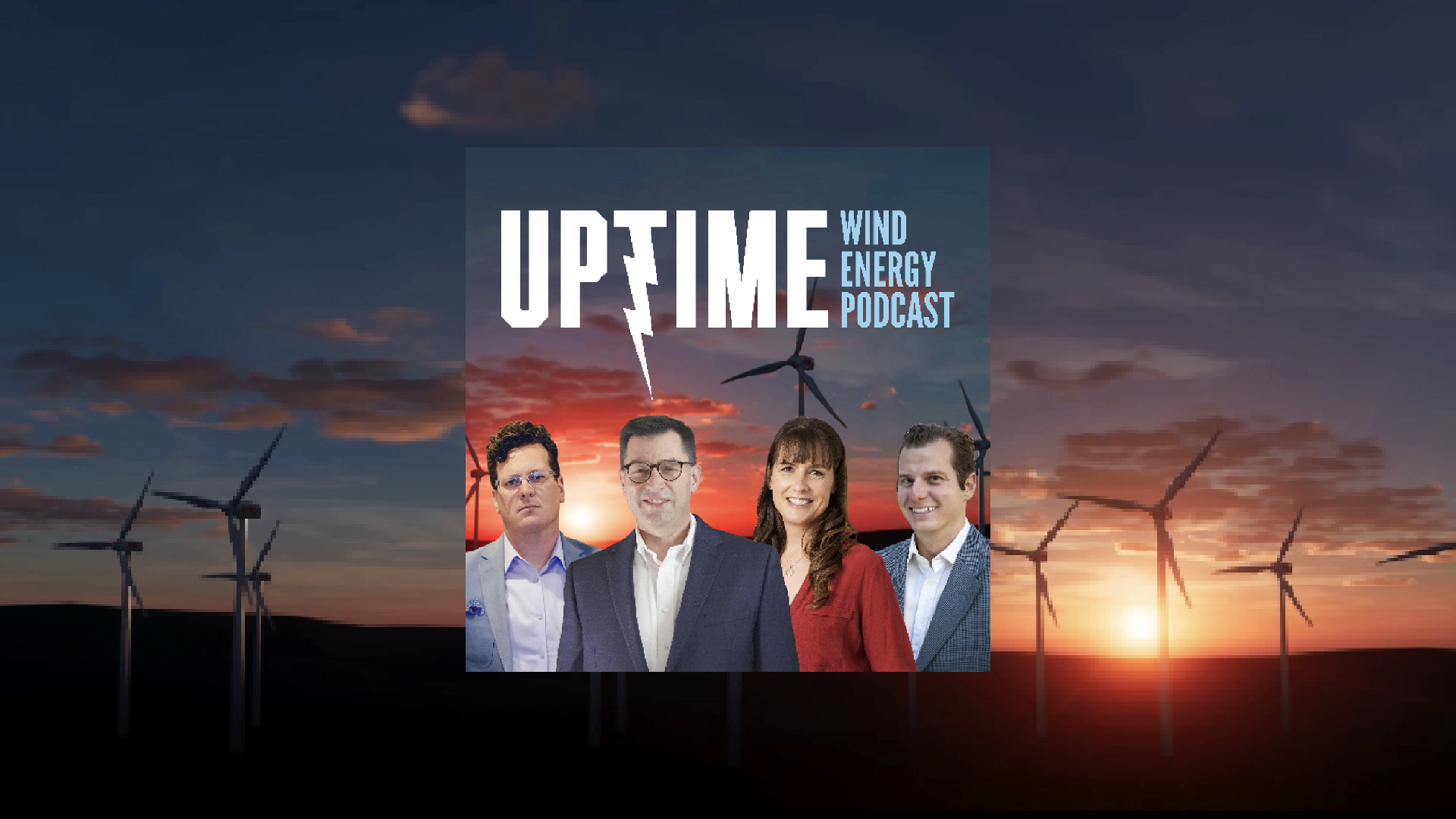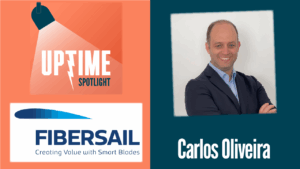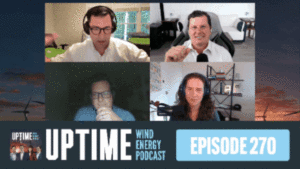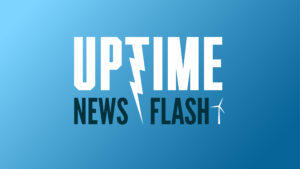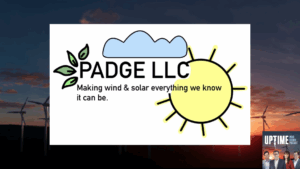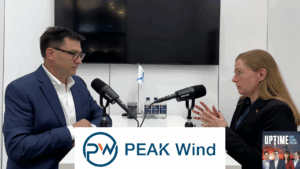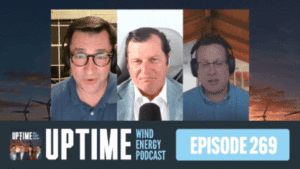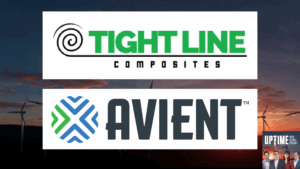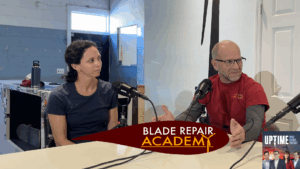Podcast: Play in new window | Download
We hope you had a good Thanksgiving break! Allen and Phil dive into offshore news with Netherlands-based LiftOff and their uptower crane system. Recent successful MCE projects bode well for Liftoff in 2025. Plus, TPI Composites announced their Q3 results. Turkey’s inflation pressure and a shift to more American-based manufacturing is tamping the near-term growth.
Pardalote Consulting – https://www.pardaloteconsulting.com
Weather Guard Lightning Tech – www.weatherguardwind.com
Intelstor – https://www.intelstor.com
Join us at The Wind Energy O&M Australia Conference – https://www.windaustralia.com
LiftOff – https://liftoff-mce.com
Allen Hall: Phil, I hope you had a good Thanksgiving and a lot of turkey. I did. Thank you. I hope you did too. I did. And one thing that goes with all the tryptophan and that turkey is caffeine, so you can fight off the tryptophan and watch your favorite football team lose. And during this time, Duncan’s been working, which is a big coffee producer in the United States is trying to break world records.
And so they hooked up with Nick DiGiovanni to break the Guinness World Record for the largest ice latte. And that ice latte was in an 11 foot high Dunkin Cup with ice milk and espresso. That’s what a latte is, right? And it turns out that the Guinness World Records confirmed that it was 276 gallons in that cup.
And the question is, what did they do with all that latte? That’s a lot of latte. Hopefully everybody drank
Phil Totaro: that. You’d hate to think they would waste it.
Allen Hall: According to Duncan, they served it To 300 employees at the corporate office in Massachusetts. Now, if you do the math on that’s roughly a gallon of latte per employee.
Phil Totaro: That’s a lot. I know some people that do drink a lot of coffee. I don’t I guess I’m naturally a brilliant, but like some people need that much, I don’t know. Holy cow, that’s
Allen Hall: a lot of coffee. This could be a lot of sleepless nights in Massachusetts from all the Dunkin employees.
And productivity’s gotta go way up.
The latest P. E. S. Win Magazine has a number of great articles in it, and if you haven’t PESWin. com and you can download it for free and read all the articles in it. And one of the more interesting articles that I thought was in this one is an article from Liftoff. And we’ve had Elko May from Liftoff on the podcast previously.
And Liftoff is an offshoot of a podcast. arm of Liftworks, which is, Liftworks does onshore wind, heavy lift, and crane work, using a unique process to do that. And Liftoff is doing all the offshore work for Liftworks, and Liftoff is based in the Netherlands with Elco, and it has done a number of, a couple of amazing things this over the last couple of months, really.
They’ve done some crane technology work on fixed bottom offshore winds, where instead of using jackup vessels to do maintenance, they’ve got the system now to work, where they can handle up to 9. 5 megawatt capacity turbines without using jackup vessels. So they’re using standard containers.
on flat barges that are moved around via tugs. Now, Phil, this makes a ton of sense to me because the expensive part, as we always say on Offshore Wind, is not really the turbine, it’s the jackup vessels and all the specialized ships you need to go do this work, and liftoff is eliminating a lot of that and simplifying MCE for some of these tournaments.
Phil Totaro: Yeah. And what strikes me about this is actually something slightly unrelated, which is Cattler just came out with their quarterly report saying that the demand for their services is huge right now. So maybe Liftoff helps alleviate some of that burden much to the chagrin maybe of Cattler.
But it’s great. They can take, a technology that was developed for onshore and deploy it offshore. In, in that, you don’t always have the same obviously weather and site conditions. But the way in which the, this liftoff system works is using this kind of gen hook, what they call a gen hook.
Which is a multi winch system that allows you to, better balance a load. And I think that’s probably one of the keys to how they’ve been able to more rapidly deploy this offshore is the fact that they have a winch system that allows for, whether it’s a gearbox swap out or even a, blade swap or some other uptower component this is a system that, will allow you to avoid, not only avoid using the vessels, but avoid using any kind of crane, other than the onboard crane avoid using any other type of crane because it, I don’t even think this needs transition piece based support cranes or anything like that, so this is fantastic and the fact that they can just lift or lower things, off of or onto a barge. Makes things a heck of a lot cheaper when you’re talking about doing, any kind of maintenance work, whether it’s a fixed bottom or a floating. I recall, didn’t they Alan, didn’t they test this at the Kinkerton floating offshore wind farm in the UK?
Allen Hall: Yeah they did a floating platform Kinkerton. Generator exchange on a Vestas turbine, a nine and a half megawatt Vestas turbine, which is quite remarkable. Now, obviously floating turbines, everybody from the engineering side says, if you have a problem, what are you going to do? You’re just going to tow it back to port and fix it.
Except that is also really expensive and it’s a lot less expensive to Do something on site from Liftoff and Liftoff was able to pull that off to replace that nine and a half megawatt generator on that floating platform. So it took them a while because they were trying to navigate the weather, obviously, with this floating platform, the up and down and all the crane motions and trying to keep everything steady, but they did it.
So even if it took a little bit longer time to do it. It’s shorter than hauling that whole platform back to shore and trying to do the work there. This is remarkable. This kind of technology, this kind of engineering is going to change floating wind for sure because built into the cost model of floating wind is dragging it back to port.
Or using an expensive jacket vessel on this floating platform, which is really complicated. That’s all built into the model. And if Liftoff can change that financial model, maybe that’ll help lower. The cost of electricity from some of these floating platforms, which make it much more enticing for operators and governments to go after.
So this is really good from Liftoff and Preston. Maybe we’ll have Elko May back on the podcast again, because he’s a good person to talk to. Yeah, but if you want to learn more about PES Wind and this Liftoff process and Just go to PESWin. com and download the article. It’s a really good one.
As busy wind energy professionals, staying informed is crucial. And let’s face it, difficult. That’s why the Uptime Podcast recommends PESWin Magazine. PESWin offers a diverse range of in depth articles and expert insights that dive into the most pressing issues facing our energy future. Whether you’re an industry veteran or new to WIND, PES WIND has the high quality content you need.
Don’t miss out. Visit PESWIND. com today.
Allen Hall: Phil, we haven’t talked about TPI in a little while but their Q3 results were announced. And just to give you some background here, sales for Q3 was about 380 million, which is about 2. 5 million. To 2.5% increase a little more than two and a half percent year on year.
And adjusted EBITDA was roughly 8 million versus 200,000 a year ago. And the net loss this in Q3 was about $38 million versus 43 million last year. Now, a couple of positive things about GPI. 89 percent plant utilization, so their assets are being worked pretty hard. And they have 10 production line transitions complete, and the asking price for a blade increased to about 200, 000 from 175, 000.
So prices are going up a lot. On wood turbine blades. Now, it’s a little hard to gauge because also the length of the blades are increasing, so Sizes are going up, yeah. Exactly, so the weight of the blade is going up, so prices have to go up with it. Now, a couple of strategic moves here. They are reopening the plant that they had in Iowa for GE.
And GE plans to have TPI produced 2 megawatt blades there, which are very popular in the repowering scenario. So a lot of older 1. 5 sites, Siemens, Gamesis sites, are getting repowered with GE 2 megawatt turbines. Great. And there’s Also considering or in the process of acquiring another plant in the United States, what they call a brownfield plant to build more blades in the States.
Now, not a lot of discussion about who is asking for that. My guess is GE, but it could be Nordex or it could be Bestos, honestly to see where that goes. But all right, so they’re moving some of their plants back into the United States. And as you pointed out earlier, Phil, it’s probably a 45x tax implication.
This is
Phil Totaro: presumably to in addition to taking advantage of the 45x manufacturing tax credits, this is presumably intended to ward off the incoming administrations implementation or proposed implementation of tariffs on goods, particularly, renewable energy related goods manufactured in Mexico, China, and Canada of which I suppose we do import technology from all three markets, although Canada it’s just, Blades for GE for offshore turbines from their plant in Gaspé.
We don’t get a lot of other components anymore. We used to import some towers until, Arcosa and Broadwind complained about that. So You know we’re at a point now where, okay, companies, including TPI, want to be able to take advantage and on behalf of GE want to be able to take advantage of the 45X manufacturing tax credits.
Keep in mind that the reason why GE’s on this is usually in the supply contract, the bulk of that 45X tax credit benefit goes to whoever’s buying the blades. And even I’ve had word from, project development companies and asset owners who have said, we’re also demanding that GE turn over a portion of that manufacturing tax credit to us when we buy the turbines.
So that’s, it’s all getting fascinating and a little complicated there. As far as who’s really taking out the benefit of the tax credits. But in the meantime it does mean that you’re seeing some re domestication of production. But it’s also coming with this backdrop of this cloud hanging over LM at the moment.
And one questions why TPI’s performance isn’t better than what it is, considering the fact that There aren’t that many independent blade producers out there anymore. Let’s put it that way, and NLM isn’t even an independent. Obviously they’re a subsidiary of GE. So for TPI to be able to, sustain its business, obviously I think that a lot of the stock price thing downward movement is largely because of everybody’s fear that, onshore wind tax credits may go away or, projects are going to get slowed down or this, that, whatever.
But if they’ve already got an 89 percent chance factor utilization rate. I don’t see that slowing down anytime soon, because as we’ve talked about on the show you’re still going to see, this year hasn’t been the world’s best in terms of capacity additions in the US. But if interest rates do start to, going down next year, which again, we’ve, and we’ve talked about on the show, and anticipated, a mild, if not moderate recession where companies just, start laying off people, just tried to take advantage of the fact that interest rates are high and they want them to go down.
So they just start mass layoffs and say, we want to induce this behavior in the Fed to try and get interest rates to lower faster soon. That can lead to a scenario where a company like TPI can take advantage of the fact that there’s going to be a lot more, orders potentially coming in for 26 and 27 delivery.
Where You know, companies that are seeing, project development companies and investors that are seeing interest rates coming down next year are gonna start plowing some money back into, renewable development projects. So I think TPI’s prospects are a little bit better than what the mood is currently around the company.
Allen Hall: So TPI obviously is a global company. And a lot of the operations are down in Mexico, but there’s also a substantial number of blade lines over in Turkey. And I think that the Turkey plants are really in question at the moment, just because they expect like a 40 percent reduction in Turkey in 2025.
That’s, Massive. Now, NORDEC contracts I think for eight lines are going to expire at the end of 25. I think Vestas may have picked up a couple of those. However, Turkey is a really unique market in that a number of Chinese manufacturers are trying to enter that market. Turkey itself, is a big renewable country.
So a lot of blades end up there or into Europe. But hyperinflation is a problem in Turkey right now. So raw materials can get to be a problem, which is increasing the price where this is where the Chinese are coming in and trying to undercut TPI. So now TPI has got a multi front problem.
They’re trying to deal with 45 X tax implications in the United States, trying to move operations to the United States. At the same time. Europe is a little bit slowing down and the Turkey market has gotten a little unstable for them, which just adds to the losses. So meanwhile, while everything is in flux, TPI is trying to say, Hey, long term, we’re going to be fine.
But our forward looking statements of a year ago are probably not going to be right because we didn’t expect this Turkey Piece to become so unpredictable. And how do they try to navigate that, Phil, that’s just as a global company and their stock prices is so low, there’s not a lot of wiggle room here.
Where do they go?
Phil Totaro: Yeah, it’s it’s fascinating. So going to the Turkey thing first the agreements that they have with Nordics, we would expect most of that to be extended. It’s just that the agreements, as you said, they will expire in 2025. But Nordex is still doing a fairly good clip of business in Turkey.
There are, there’s still the number one OEM there, but Enercon also has just recently announced a deal with a couple of Turkish development companies for 2. 5 gigawatts, and Enercon’s also got Nacelle and Blade manufacturing capabilities there, so they’re trying to get to that. a lot of the market share that they lost.
Vestas is more competitive in Turkey now. And as you said, with the Chinese coming in, the Turkish market overall is much more competitive for a bit smaller capacity, than what they’ve been adding. Normally they’re at about, seven, six, seven, 800 megawatts a year trying to expand up to, gigawatt and a half per year onshore anyway.
But the, it’s getting a little tight, like you said, there’s things like hyperinflation that are impacting them there’s a number of things that they’re still having to try to go get, Russian gas and things against the, getting a sanctions exemption to be able to, get access to to, to Russian gas, so they’re facing some challenges that as a country that they wouldn’t have necessarily anticipated a couple of years ago, and that also trickles down then to a company like TPI, who You know, put a base there to serve customers, but also to have an export market to other countries where, you know, throughout that region of Eastern Europe where they’ve got customers they need to serve, but like markets like Serbia, Croatia they’re trying to get more of a pipeline going.
But it doesn’t mean that it’s going to be 100 percent of that business is going to go TPI’s way. And so that’s still the uncertainty that I think a lot of people are baking into the price. Does that then
Allen Hall: force TPI, and I don’t like using that word, but in a sense financially, does it end up forcing TPI to become America focused?
Phil Totaro: Potentially, yes, and it could be to their benefit or detriment, depending on, again, how much work they’re going to get from both or you could say GE, Vestas, and Nordex. Potentially, yes. Because, Nordex in North America is going to stay relatively where they are, about, a gig or two a year.
Vestas could grow them. But Vestas also leverages their own internal manufacturing and LM for particularly a lot of the turbines that they’re selling in the market now, which is the V163, the V150 and even the 6 megawatt platform. So You know, is TPI really going to get a lot of that business?
Potentially. Again, if LM continues to falter or looks less competitive, that may be good news on the Vestas front. GE will continue to rely on TPI, particularly for older models. Like you said they’re extending the relationship to continue doing the two megawatt blades or even the blades that are retrofit onto the 1.
5 megawatt platforms, the, the 87 meter rotor, the 91 meter rotor. Those are pretty much all a TPI thing at this point,
Allen Hall: but isn’t that where the vast majority of growth will happen is in that two megawatt band of turbines that the six megawatts are going to happen, but the repower almost is forced to go back to the two megawatt and GE has aligned itself to being really successful there.
They need to be really successful there. So that’s a bonus for TPI. going to ride that wave a little
Phil Totaro: bit. Yeah, and it’s interesting because, again, depending on And we’ve talked about, the implications of the election and all that sort of thing on what happens in the market. But if we’re going to be more of a repowering market than a greenfield buildout market, then that could be good for TPI.
But again, I don’t think everybody really appreciates the extent to which, things are going to shift. And I say that deliberately, because I think that a repowering market helps TPI more than a greenfield build out because in a greenfield build out, they might be more likely to use larger turbines now that those larger turbines are A.
available and B. proven in the market. You’ve got Vesta selling their 6 megawatt, you’ve got Nordax selling the 7 megawatt. The 5. 5, 5 to 5. 5 megawatt platform and also bringing the N169 or trying to into the market as well. And you’ve got, companies like GE that want to be able to roll out the Cypress platform as well over here.
That’s great
Allen Hall: stability though, Phil, right? That ends up creating stability for like a TPI and the problem that TPI has had over the last couple of years is that they get thrown new designs that they’ve tried. that don’t have a lot of vetting before they get out service and they, and TPI said that their warranty costs were still hanging around.
It was about 7 million in the quarter of legacy costs and that now that they’re trying to, they’re getting over the hurdle of a lot of warranty repairs and then technicians can get on to other kinds of repairs. They’re learning, earning more money from their maintenance business than just go out and fixing the stuff they just produced, which.
Looking forward, if they’re not making a lot of new blades or making the same blade over and over again, you would think that the, and with prices coming up a little bit, they would be in a much better financial position, but the stock market has not awarded them that yet. They’re still holding down the price at crazy low levels, in my opinion.
You would think that would change and you just don’t see Wall Street looking at the two, three year timeline for TPI and saying this is going to grow.
Phil Totaro: Yeah, and like we’ve just talked about, I think if they’re going to get more A bigger chunk of the repowering market, that’s a good thing for them, and that should be rewarded.
Particularly as it looks we’re going to still have, new project build out where we kind of work through what’s in the interconnection queue at the moment, even if the interconnection queue starts slowing down or getting, stopped or impeded in some way. That doesn’t have an impact on the market until like 2027.
So in the meantime, TPI is in a position to, be able to capitalize on the existing market conditions, including what we’re anticipating in the first and second and third quarter of next year. So.
Yeah.
Phil Totaro: I think you’ve got
a point. Unlock your Wind Farm’s best performance at Wind Energy OM Australia.
February 11th to 12th in sunny Melbourne. Join industry leaders as they share practical solutions for maintenance, OEM relations and asset management. Discover strategies to cut costs. Keep your assets running smoothly and drive long term success in today’s competitive market. Register today and explore sponsorships at www.
windaustralia. com.
Allen Hall: Well, Phil, Equinor made an announcement that they’re going to cut 250 positions from its renewables unit, and that’s really focused on offshore wind. Equinor named a couple of different reasons why this is happening. Inflation, obviously, interest rates, supply chain bottlenecks, margins are going to be lower.
But it does feel like the change in the Trump administration is a big part of this. And it started, it seemed like it started a couple of months ago. Like they could see the writing on the wall, like if this happens, we’re really going to have to make a decision sooner rather than later. And now Equinor is making the, that happen.
A lot of the people that are going to leave the offshore wind business are being transitioned back to oil and gas because that’s where Equinor makes the vast majority of its revenue.
Phil Totaro: The reality of this is that, they, a lot of people want to pin this on the incoming Trump administration and say that, if your project didn’t already have an offtake agreement or didn’t already have, approval from BOEM or this, that, whatever you’re probably dead in the water anyway, but the reality of it is if you don’t already have a PPA and if, Attentive Energy One decided not to move forward with their with their bid.
Attentive Energy Two did have an offtake for for New Jersey but that project was a lot. In its development process and the fact that they already have an agreement in place is why they’re still keeping the door open to that phase of the project moving forward. But the interest rate environment and the, as you just said with Equinor moving people back into oil and gas.
That’s also what Total is doing. That’s what Shell is doing. That’s what BP is doing. Every single one of the oil and gas players that has made a foray, particularly into offshore wind, and particularly in North America, where they’re seeing this high interest rate environment, they want out. And that’s what they’re doing is just transitioning everything back.
So the point here is, and the message I take away is, we need to create a market environment in which investment is fostered. And in the past four years I can’t see how we’ve made all that much progress because, even if companies have, started building and commissioning some of these offshore wind farms, the fact that you’ve got major developers and players that could have been investing here, deciding to stop or pull out to lay people off, to transition back into oil and gas, that’s not a good thing for the market.
That’s not creating an environment where everybody feels comfortable parking money and investing. And the reality of it is it, that’s not going to change. Again, we’ve talked before on the show about what we think is going to happen with interest rates and everything in 2025. But that’s still, even if interest rates change overnight, that’s not going to bring all these oil and gas players back into the market immediately.
So you’re talking about redeployment of a lot of people that were focused on renewables back into oil and gas and across multiple different, five, six, seven different companies. And that’s not going to end up being a good thing for retaining the knowledge base that we need in order to, expedite the development of, offshore wind, particularly in a market like the U.
S. So what do they do with the leases?
Allen Hall: What do Totaro and Equinor do with the leases? And then these are bite leases, which they paid a tremendous amount of money for at the time. Are they going to just let them go and just say it’s a write off? Or they, or the plan just continue to pay down on the lease month to month, and then when the time is right, try to develop them?
I guess it’s the same thing they do in oil and gas, right? There’s a lot of money in the ground that they haven’t even developed, so they’re paying leases on plots of land all over the world, and maybe that’s just part of business in oil and gas, and they’re just used to it.
Phil Totaro: Yeah, and it’s a question of, okay they’re gonna have, a few million bucks a year in lease payments to make versus the tens of millions a year in development costs that you’re going to incur on a project that’s not able to move forward because you can’t secure a PPA and or you’ve got local opposition, which, starting next year, the Justice Department isn’t going to stand up anymore and help the development companies defend against all these, save the whale people.
We’re. We’re at a point where, every, everybody can see the writing on the wall at this stage, and they’d rather, reallocate their resources where they think they’re gonna get a better bang for their buck. It just leaves you with the with a bad taste that, why couldn’t we get our act together sooner because this could have been, we could have fulfilled the promise of this market, but, how many factories got the plug pulled because nobody got the order book because we couldn’t get, PPAs at the right prices because, and et cetera, et cetera, et cetera.
And it’s just, all of these things have conspired against investment being fostered in, This industry, and I think it’s a shame.
Allen Hall: Yeah, it snowballed rather quickly, didn’t it? It seems like over roughly a year’s time span, it went from very lucrative to non existent. And that is not helpful.
Phil Totaro: To answer your question though, they’re probably going to hold on to the leases. They could sell them. And, but there’s no deadline necessarily for them to to actually develop and implement a project. The lease payments are there whether they’re building something or not. That’s a corporate decision that they can make.
But like I said, I mean, you’re gonna potentially be willing to make lease payments for a couple million bucks a year as opposed to spending ten million a year on a development that you know is not gonna get built potentially now for another, five, six, seven years. You’re not, you’re basically not going to be able to move forward on it because you don’t have all those pieces in place that you thought you were going to have, like the factories, like the government support, like et cetera, et cetera, down the list.
So it’s, I think everybody’s just playing wait and see at this point. Some of those, let me put it another way. If you’re I don’t know who’s a, what’s a good name. I’m literally struggling to think right now who would come in and actually buy those leases off, when they paid whatever, four hundred million dollars for one of those New York Bight leases they didn’t, the Empire lease, at least And, into the into the hundreds of 100, 200 million for the New York bite leases who’s going to come in and allow them to recoup that loss?
They’re either selling it. So if they sell it, they’re selling it at a loss, presumably, if they’re going to sell it. Or they’re just going to hold it until the environment in which we all operate here changes and improves to the point where you can get a project built cost effectively. That’s gonna do it for this week’s
Allen Hall: Uptime Wind Energy podcast.
Thanks for listening, and please give us a five star rating on your podcast platform and subscribe in the shows below to Uptime Tech News, our weekly substack newsletter. And check out Rosemary’s YouTube channel Engineering with Rosie. And we’ll see you here next week on the Uptime Wind Energy Podcast.



